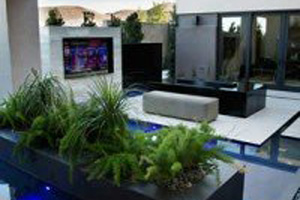For years, Las Vegas has been a place where thoughtful architecture goes to die, with cookie-cutter stucco homes, strip malls and mid-rise office buildings blanketing the valley.
The luxury-home market is no different, with supersized Tuscan-style mansions stuffed with the same toys and amenities.
Homebuilder Tyler Jones, however, is adding a dash of style to this look-alike landscape.
Jones, through his Las Vegas company Blue Heron, is developing three communities of high-end, desert-themed luxury homes in Henderson and has built custom homes around the valley. He founded the company with his father and has been in business for a decade, getting project sites that flopped under previous owners and racking up numerous design and environmental awards from construction-industry groups.
The 37-year-old Las Vegas native tries to blend indoor and outdoor space, and subtly packs his cube-shaped homes with electronics.
The design, he said, is “Vegas Modern.”
At his four-bedroom, 5,800-square-foot model home at Sky Terrace — a development off Sunridge Heights Parkway near Eastern Avenue — most doors are automated, glass pocket-doors that glide completely into the walls. Outside, the courtyard has a water wall, fire pit and flat-screen TV. There are three other fire pits, including on the rooftop “skydeck,” which also boasts a wet bar.
There are more than 20 flat-screen TVs scattered around the house, with several hidden behind mirrors, including two alone in the master bathroom. The kitchen bleeds into the living room, and walking around the house, it can take a while to realize that bedrooms and hallways are nowhere in sight.
“We want it to feel open,” Jones said.
Most luxury homes in the valley not only look the same but often have the same perks — movie theaters, elevators, gyms, wine cellars, massage rooms, libraries, gaming and billiards rooms, outdoor kitchens, and manicured landscaping with palm trees, ponds and swimming pools.
Bob Fielden, a longtime valley architect, said these homeowners want their houses “to be as pretentious as possible,” partly to outdo each other, and partly because they think it will boost the resale value.
“I don’t know how anyone could ever be comfortable in something like that,” said Fielden, principal of Henderson-based RAFI Architecture.
Jones also offers over-the-top amenities — the model home at Sky Terrace has an elevator, outdoor kitchen and entertainment room that includes a 105-inch drop-down TV screen.
But overall, Fielden said Blue Heron’s designs are “probably light-years ahead of anyone else in the market.”
“They’re different ways to live,” he said.
Still, Fielden questioned why Jones uses so much glass in the houses, saying the panes will trap heat. Shelly Stewart, Blue Heron’s director of sales and marketing, said the company uses low-emissive glass, which has been treated to reflect heat while letting light in.
Like other aspects of real estate, Las Vegas’ luxury-home market soared during the boom years last decade, collapsed with the bust, and is now on the rebound.
At the peak of the bubble, in 2005, builders sold 226 new single-family homes in Southern Nevada that cost at least $1 million each. That dropped to just three in 2013 but bounced back to 34 last year, according to Las Vegas-based Home Builders Research, whose figures don’t include custom homes.
Projects in the works include Ascaya, the long-delayed mountain-mansion development in Henderson that reopened for business last year. And in Summerlin, developers Howard Hughes Corp. and Discovery Land Co. are planning a 555-acre high-end community.
The revival comes as buyers pull back from used mansions. The Greater Las Vegas Association of Realtors, which mostly tracks previously owned homes, says 300 homes sold for at least $1 million each through its listing service last year, down 12 percent from 341 deals in 2013.
Jones attributed the jump in new-mansion sales to easier financing, and said resales are slipping because buyers already picked up many of the discounted, foreclosed mansions that became available after the bubble burst.
Meanwhile, the improved stock market has created a windfall for would-be buyers, and builders are opening construction sites again, giving house-hunters more options, Home Builders Research President Dennis Smith said.
“There are more new products available,” he said.
Jones, who grew up riding dirt bikes at Eastern Avenue and what’s now the 215 Beltway, went to Bishop Gorman High School and studied architecture at the University of Colorado, Boulder. It wasn’t a leap to get into real estate. His father, Steve Jones, had launched Merlin Contracting and Developing, a custom homebuilding business, in 1989.
They founded Blue Heron in 2004 and have sold about 150 homes. Their houses range from 3,400 to 15,000 square feet and are priced between $1 million and $7 million.
The Joneses are majority owners, though Tyler runs day-to-day operations and is the lead designer.
Besides custom homes, they are developing three communities — Sky Terrace, Marquis Seven Hills and Horizon Lights. All have troubled pasts.
Previous owners of the Sky Terrace site reportedly were underwater and sold cheap during the downturn. At Horizon Lights, the original developer built just four homes before losing the site to lenders. And at Marquis, previous owners built two model homes before ditching their plans and selling the site.
Jones builds slowly — it takes eight to 12 months, if not more, to complete many Blue Heron homes — but unlike other builders who have come through the valley, he’s not trying to work at warp-speed.
During the boom years, when builders sold tens of thousands of homes a year in the valley, it seemed almost no one cared about building something unique. They just wanted to build fast, and buyers didn’t seem to care.
Las Vegas wasn’t always that way — the vintage mid-century moderns near downtown, for instance, show a different era of stylish architecture — but “then you got into this mass-production mentality,” Jones said.
“Everything’s a beige stucco and a red-tile roof,” he said.

